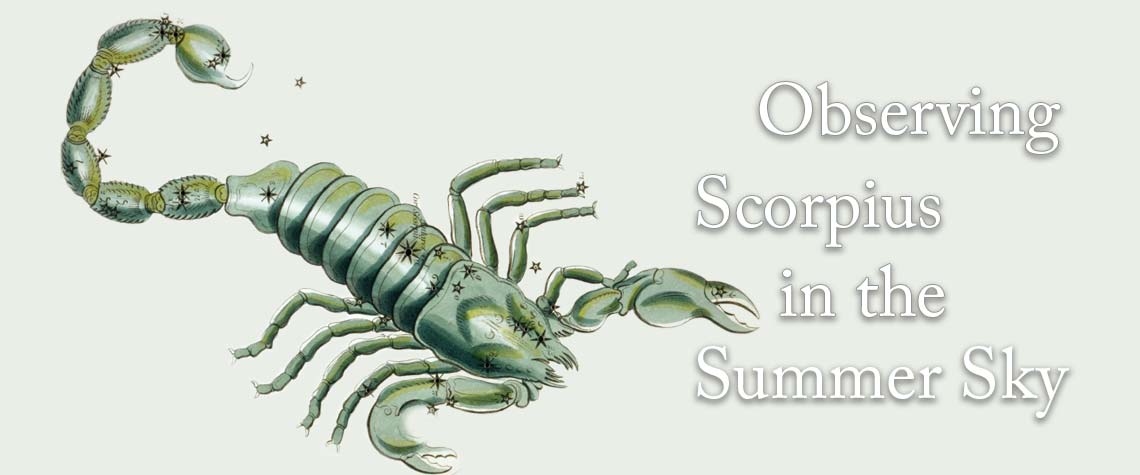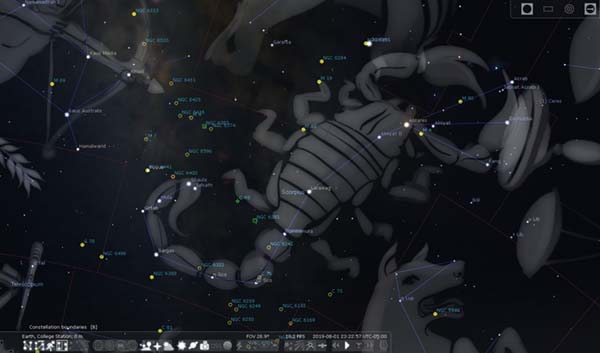Page 4


Eye on the Sky - Scorpius
By Tom Campbell
In Greek mythology, Scorpius is the scorpion sent by Gaia to kill Orion after he boasted he would single-handedly hunt and kill all the animals on Earth. Even after both were immortalized in the sky, Orion fears Scorpius and is never seen in the sky at the same time.
Even though the long scorpion tail is easily recognizable, other cultures saw the constellation very differently. The Maori people of New Zealand saw the constellation as Maui's fish hook, which got snagged on the bottom of the sea. When Maui tugged and pulled, it brought up the islands now known as New Zealand. Other cultures see this grouping of stars as a palm tree, a mother holding a baby in a sack on her back, a sting ray, or even as a serpent.
Facing near the center of the Milky Way, Scorpius is full of interesting objects.
Antares is a red supergiant star which happens to lie near the ecliptic (the plane of our solar system). Its name means “Rival of Mars,” as it can sometimes be mistaken for the red planet in the night sky. If Antares were placed in the center of our solar system, its surface would reach nearly to the asteroid belt. It has a blue-white companion star at magnitude 5.5, but it can be difficult to detect in smaller telescopes because it is easily lost in the glare of Antares.
Acrab is also a multiple star system. The main pair is easily resolved in binoculars or small telescopes. Each of these components also has a companion, but the companions are too close to be resolvable by most amateur instruments. Both main stars are blue-white, with the B component being a couple magnitudes fainter.
Messier 4 is a very loose globular cluster, consisting of several tens of thousands of stars. One of its most unique characteristics is that most of its brighter members form a bar across the center of the cluster.
Messier 6 is an open star cluster and has also been called the Butterfly Cluster due to its shape in small telescopes. Most of the 120 member stars are hot and blue, but the brightest member, BM Scorpii, is a much cooler orange giant.
Messier 7 is another open cluster. This one has been nicknamed the Ptolemy Cluster because he first described it as a naked eye nebula in 130 AD. This is the southernmost of the Messier objects.
Messier 80 is a globular cluster located about 32,600 light years from Earth. It spans about 95 light years across and contains several hundred thousands of stars.
Caldwell 69, sometimes called the Butterfly Nebula or Bug Nebula, is a bipolar planetary nebula. Its central star isn't visible in amateur telescopes but is one of the hottest known stars, at 250,000°C.
Caldwell 75, also designated NGC 6124, is an open cluster of about 125 stars located approximately 18,600 light years away.
Caldwell 76, or NGC 6231, has been popularly called The Northern Jewel Box. The naked eye star ζ1 Scorpii is the brightest member of this open cluster. The cluster is traveling towards us at 22 km/sec, which should put it in the vicinity of the Sun in about 76 million years. In my 8-inch Dobsonian, I was able to note some differing colors in some of the stars.
NGC 6281 is also known as the Moth Wing Cluster. This is the brightest open cluster in Scorpius which is not a member of either the Messier or Caldwell catalogues. James Dunlop described the cluster as a “curiously curved line of pretty bright stars, with many stars mixt.”
| Object | Type | Mag(s) | Dist. (ly) | R. A. | Dec. |
|---|---|---|---|---|---|
| α Sco (Antares) | Double Star | 1.0, 5.5 | 550 | 16h 29.4m | -26° 26' |
| β Sco (Acrab) | Multiple Star | 2.6, 4.9 | 400 | 16h 05.4m | -19° 48' |
| Messier 4 | Globular Cluster | 5.9 | 7,200 | 16h 23.6m | -26° 32' |
| Messier 6 (Butterfly Cluster) | Open Cluster | 4.2 | 1,590 | 17h 40.1m | -32° 13' |
| Messier 7 (Ptolemy Cluster) | Open Cluster | 3.3 | 980 | 17h 53.8m | -34° 48' |
| Messier 80 | Globular Cluster | 10.0 | 32,600 | 16h 17.0m | -22° 59' |
| Caldwell 69 (Butterfly Nebula) | Planetary Nebula | 7.1 | 3,400 | 17h 13.7m | -37° 06' |
| Caldwell 75 | Open Cluster | 5.8 | 18,600 | 16h 25.6m | -40° 40' |
| Caldwell 76 | Open Cluster | 2.6 | 5,600 | 16h 54.0m | -41° 48' |
| NGC 6281 (Moth Wing) | Open Cluster | 5.4 | 1,611 | 17h 04.7m | -37° 59' |
